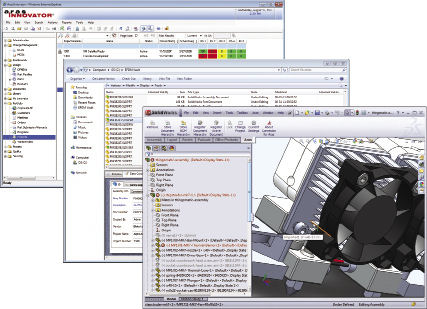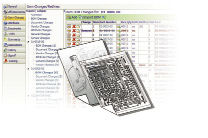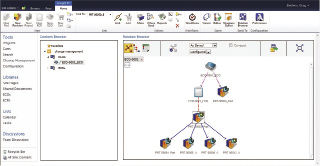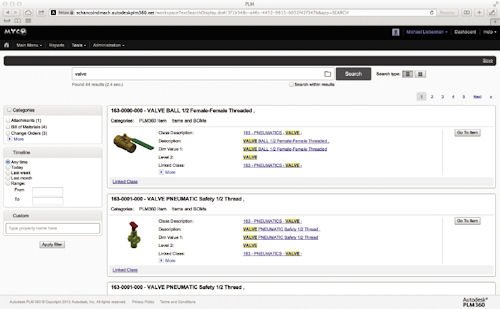Vendors Try to ‘Rightsize’ PLM for Smaller Businesses
Making product lifecycle management more palatable to smaller businesses by simplifying configuration and leveraging the cloud.
May 1, 2013
Increasing product complexity. The need to coordinate development processes across a globally-dispersed design team. Placing a greater emphasis on innovation and time-to-market agility. These challenges, once stumbling blocks for only the largest manufacturers, are now bearing down on small- to mid-size businesses (SMBs) as they seek to optimize product development organizations and engineering processes in an effort to gain a competitive edge.
“Companies of all sizes have a pretty common theme in terms of increasing product complexity, process complexity and globalization,” says Marc Lind, senior vice president of marketing for Aras.
With mechanical components only part of the overall product structure, today’s greater reliance on electronics and software has both large and small shops struggling to coordinate design across multiple disciplines. Moreover, firm size no longer dictates supply chain and partner complexity. Whether a company has 20 people or 20,000 people, Lind says, there’s a strong likelihood that some are spread across the globe.
 Aras EPLM for SolidWorks EPDM is a scalable and secure business-ready solution aimed at driving cross-functional PLM processes throughout a company and its supply chain for global collaboration and coordination. Image courtesy of Aras Corp. |
For more than a decade, larger manufacturers have come to rely on product lifecycle management (PLM) to help deal with increasing design and manufacturing complexity, but the software tools have traditionally been expensive and difficult to deploy, keeping smaller companies at bay. PLM vendors have struggled to break into the SMB market, but their approaches—mostly scaled-down versions of enterprise offerings with key functionality removed—haven’t convinced smaller companies that PLM is the right set of tools and processes to solve their product development pain points.
“SMBs have the same types of problems as larger companies, but the concept of PLM is frightening to them because it’s been expensive, complicated, and they think it’s going to slow them down,” says Thane Hathaway, owner of EAC Product Development Solutions, a PTC value-added reseller and engineering consulting company.
That’s starting to change as PLM vendors rethink their SMB strategies and embrace emerging technologies to make the tools more palatable to smaller customers. Some, like Autodesk, view the cloud as their ticket into the SMB space. Other longtime players, including PTC and Siemens PLM Software, are making core CAD data management and engineering change order functionality more approachable through support for commonly used systems like Microsoft SharePoint, new ease-of-use features, and out-of-the-box configurations. Newcomers like Vuuch and Kenesto are radically rethinking the concept of PLM, moving away from simplifying traditional interpretations and toward promoting wholly new concepts around collaboration and engineering process workflows.
According to Tony Christian, director at industry analyst firm Cambashi, there are five forces driving the PLM market and making the technology more SMB-friendly:
· cloud;
· mobility;
· improved integration with complementary applications;
· social networking and new collaboration functions; and
· ease of use.
“Those five technology factors are all interdependent, and they are all areas in which PLM vendors are moving their solutions forward in quite an aggressive way,” Christian says.
PLM Heads to the Cloud
Of all the vendors in the traditional design tool space, Autodesk is taking the most extreme approach to rightsizing PLM for SMB customers. Citing smaller companies’ need for a PLM system that is easy to implement and maintain, and the requirement to keep costs in check, Autodesk has placed a bet on the cloud as the most effective delivery medium for SMB customers.
 Omnify is courting SMBs with Empower PLM’s flexible licensing plan, multiple deployment models and out-of-the box configuration. Image courtesy of Omnify Software. |
The Autodesk PLM 360 offering neither requires customers to build out an expensive IT infrastructure to run PLM, nor requires on-site staff for ongoing support and maintenance. It emphasizes a workflow engine and capabilities such as program management, quality management, and supplier collaboration—as opposed to many SMB PLM systems, which target product data management (PDM).
“PLM is essentially a technology that allows manufacturers to solve and improve business process problems, and PDM is just part of that,” explains Richard Blatcher, senior industry manager for manufacturing at Autodesk. Autodesk provides core PDM capabilities via its Vault offering, which remains an on-premise application and is separate from PLM 360, although the two capabilities can be easily integrated, he says.
Without the broader set of PLM functionality, a tool doesn’t solve the problem of facilitating communication and collaboration with all the stakeholders involved in product development, Blatcher contends. “If a system is used entirely within the engineering department, you’re only involving 10% of the individuals and processes that need to be improved,” he explains. “It’s only solving a small piece of the picture, although it’s an important one.”
 SolidEdge SP includes an out-of-the-box method to manage ECRs and ECOs. Image courtesy of Siemens PLM Software. |
 Leveraging its acquisition of Inforbix, Autodesk is adding a Google-like search function to PLM 360 to help users more easily find relevant product-related information. Image courtesy of Autodesk. |
A new version of PLM 360 released in April builds on the accessibility theme by adding Google-like search capabilities to make it easier to find relevant, product-related information. There’s also an App store, where users can tap into a catalog of predefined business processes and prepackaged applications.
For Memjet, a global leader in high-speed color printing technologies, PLM 360’s cloud approach was the linchpin for making PLM a fit for its development challenges. Given time-to-market pressures, the company needed a better way to manage product information. It also had to establish faster and more flexible manufacturing processes, according to Jeff Bean, vice president of brand and communications at Memjet. The company’s existing methods of using Wikis, email and FTP sites were increasingly becoming ineffective, but traditional PLM was too complex and couldn’t effectively accommodate the company’s dispersed team of developers and contract partners situated in the United States, Singapore and Australia.
“We needed a solution that wasn’t tied to a particular office network or server, but allowed employees in multiple offices around the world to collaborate on bills of materials ]BoM] and engineering change order ]ECO] processes,” he says. “PLM 360 allows us to bring all functions into one system. Users can now find information on parts and subsystems, access documentation attached to those parts, and manage the ECOs all from one system any where in the world.”
Addressing PLM’s Overhead Issue
Beyond the need for greater accessibility, the complexity and cost of configuring, deploying and maintaining a PLM system have been historical barriers for SMBs. Most traditional systems require an extensive infrastructure of servers and IT resources—not to mention an investment in consulting services to customize the implementation to match a company’s business processes. That’s according to Greg Dohrman, director of the data management group at IMAGINiT Technologies, a Rand Worldwide company.
“The overhead of PLM often outweighed the potential benefits that drove the project in the first place,” Dohrman says, adding that many PLM tools support process workflows that are more in keeping with a larger company, fueling the complexity for SMBs.
As an example, consider ECO management—one of the primary functions a PLM tool can facilitate. A large company might have 30 pieces of information that need to be captured and routed to dozens of people to complete a process, whereas a smaller company might require only a handful of people and forms for the same task.
“It may take a big company 20 steps in the process to know what’s going on to make the right decision,” Dohrman explains. “Whereas in a smaller organization, you can obtain the same level of quality with a three-step process and fewer people involved. An SMB PLM tool needs to support all levels of process optimization, including making it as simple as it can be to support the need.”
In this latest round of PLM for SMBs, vendors are taking that requirement to heart. Aras, for example, has designed its platform so users can customize everything from the data model to forms, templates and business rules without complex coding.
Omnify has pursued an out-of-the-box approach from the beginning, according to its CTO and President Chuck Cimalore, and continues to evolve it. This year, for example, the company is segmenting the Empower PLM platform to support vertical functionality so a system can be quickly deployed to support a quality or data management process without extensive configuration. Omnify is also exploring cloud delivery models for further ease of deployment, Cimalore says.
Mevion Medical, a longtime Empower user with just three IT staffers, says Omnify’s approach, coupled with its efforts to support the cloud, made PLM a reality for its team.
“My job is to support the business, not build out IT,” notes Ed Quinn, IT manager for Mevion, which manufacturers radiation therapy technology that advances the treatment of cancer. “I’m not looking to buy a big, honking back-end system and hire someone to keep it going.”
PLM behemoths Siemens PLM Software and PTC agree that addressing the configuration and deployment hurdles around PLM is crucial to getting SMBs on board. Yet both companies believe the greatest need is around simplified PDM—with a clear path to scaling to other PLM functions if and when an SMB sees fit.
Many of Siemens PLM Software’s SolidEdge customers have no formal data management in place. For this group, the company targets SolidEdge for SharePoint, a platform that leverages Microsoft SharePoint to manage materials such as CAD files, spreadsheets, Word documents and even visualizations, according to Bill McClure, vice president of product development. There are also workflows that extend SharePoint capabilities to handle ECOs.
“Many manufacturing companies already have SharePoint deployed, so there is ease of deployment and ease of administration,” McClure says.
For smaller shops that need the full spread of PLM capabilities, Siemens PLM Software offers Teamcenter Rapid Start. This version of the platform can be installed on a single server, is based on Microsoft SQL Server, and is available with a variety of pre-configured workflows.
PTC, too, believes the primary value proposition of a right-sized PLM for smaller companies is simplified engineering data management—with a growth path to other PLM features over time. The company’s PDM Essentials, released earlier this year (deskeng.com/virtual_desktop/?p=6744), takes aim at some of the barriers to entry by simplifying the installation and deployment process. It also packages everything in an out-of-the-box solution, including the Microsoft SQL Server database, and provides simple installation wizards to guide users through the set up, says Mike Distler, Windchill product marketing director at PTC.
 Using Autodesk’s PLM 360, Memjet’s dispersed team of engineers was able to more effectively collaborate on the design of its unique “waterfall” style color printhead technology. Image courtesy of Memjet. |
The pricing model of PDM Essentials is also designed to help smaller shops digest PLM. As opposed to the named license model used in the traditional PLM world, where every user requires a full license, PTC—along with many of its competitors in this space—is offering a floating license, which can be shared among users. PDM Essentials is priced at $2,000 a seat for a floating license.
Beyond addressing the cost and complexity hurdles, PTC says it’s essential a right-sized PLM tool provides a path to the future. In this case, users can easily transition to a full-featured PLM tool because PDM Essentials is built on the Windchill platform.
“We know that the small companies today are the big companies of tomorrow,” Distler says. “With our approach, companies learn how to use one platform; they never have to migrate to another database, and they don’t have to retrain users.” DE
Beth Stackpole is a contributing editor to DE. You can reach her at [email protected].
More Information
Subscribe to our FREE magazine, FREE email newsletters or both!
About the Author
Beth Stackpole is a contributing editor to Digital Engineering. Send e-mail about this article to [email protected].
Follow DE





